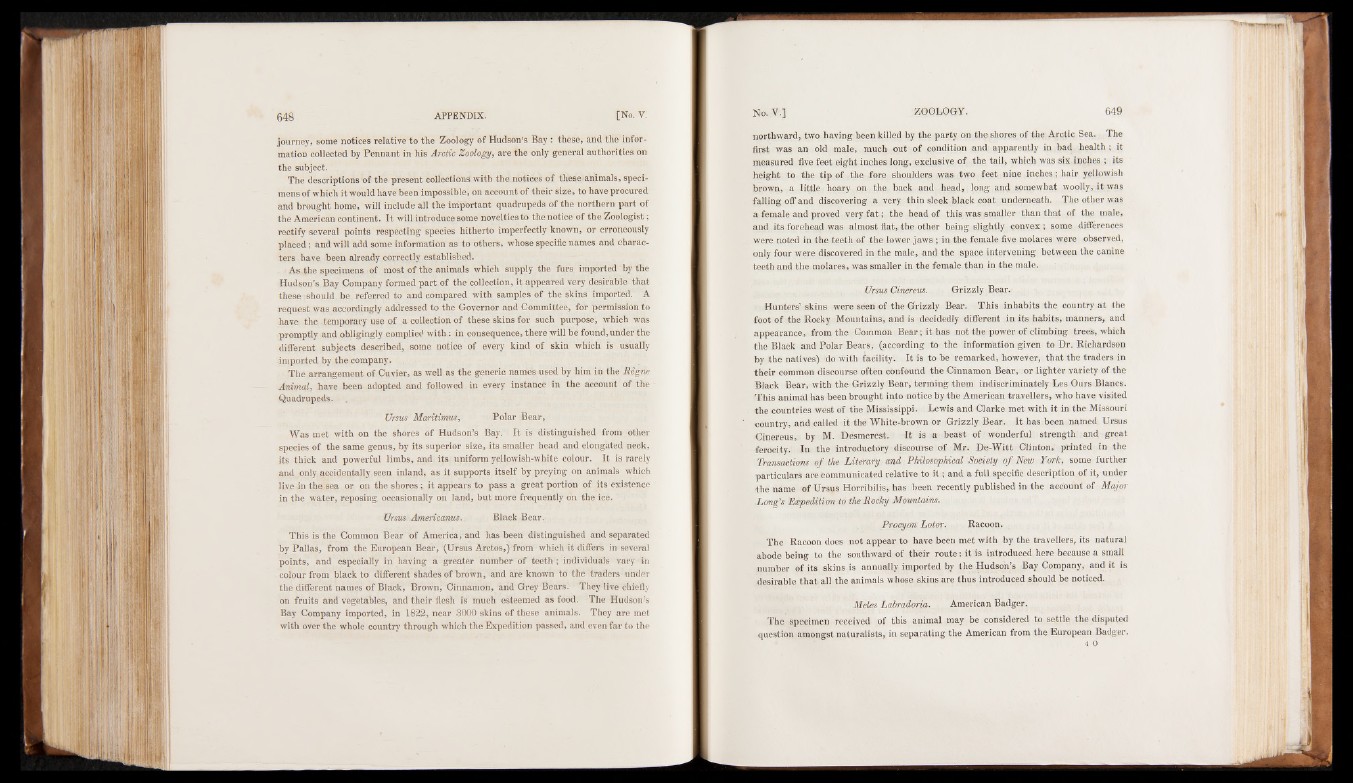
journey, some notices relative to the Zoology of Hudson’s Bay : these, and the information
collected by Pennant in his Arctic Zoology, are the only general authorities on
the subject.
The descriptions of the present collections with the notices of these'animals, specimens
of which it would have been impossible, on account of their size, to have procured
and brought home, will include all the important quadrupeds of the northern part of
the American continent. It will introduce some novelties to the notice of the Zoologist ;
rectify several points respecting species hitherto imperfectly known, or erroneously
placed ; and will add some information as to others, whose specific names and characters
have been already correctly established.
As the specimens of most of the animals which supply the furs imported by the
Hudson’s Bay Company formed part of the collection, it appeared very desirable that
these should be referred to and compared with samples of the skins imported. A
request was accordingly addressed to the Governor and Committee, for permission to
have the temporary use of a collection of these skins for such purpose, which was
promptly and obligingly complied with : in consequence, there will be found, under the
different subjects described, some notice of every kind of skin which is usually
imported by the company, jj
The arrangement of Cuvier, as well as the generic names used by him in the Règne
Animal, have been adopted and followed , in every instance in the account of the
Quadrupeds.
Ursus Maritimus, Polar Bear,
Was met with on the shores of Hudson’s Bay. It is distinguished from other
species of the same genus, by its superior size, its smaller head and elongated neck,
its thick and powerful limbs, and its uniform yellowish-white colour. It is rarely
and only accidentally seen inland, as it supports itself by preying on animals which
live in the sea or on the shores ; it appears to pass a great portion of its existence
in the water, reposing occasionally on land, but more frequently on the ice.
Ursus.Americanos.. Black Bear.
This is the Common Bear of America, and has been distinguished and separated
by Pallas, from the European Bear, (Ursus Arctos,) from which it differs in several
points, and especially in having a greater number of teeth ; individuals vary in
colour from black to different shades of brown, and are known to the traders under
the different names of Black, Brown, Cinnamon, and Grey Bears. They live chiefly
on fruits and vegetables, and their flesh is much esteemed as food. The Hudson’s
Bay Company imported, in 1822, near 3000 skins of these animals. They are met
with over the whole country through which the Expedition passed, and even far to the
northward, two having been killed by the party on the shores of the Arctic Sea. The
first was an old male, much out of condition and apparently in bad health ; it
measured five feet eight inches long, exclusive of the tail, which was six inches ; its
height to the tip of the fore shoulders was two feet nine inches; hair yellowish
brown, a little hoary on the back and head, long and somewhat woolly, it was
falling off and discovering a very thin sleek black coat underneath. The other was
a female and proved very fa t; the head of this was smaller than that of the male,
and its forehead was almost flat, the other being slightly convex ; some differences
were noted in the teeth of the lower jaws ; in the female five molares were observed,
only four were discovered in the male, and the space intervening between the canine
teeth and the molares, was smaller in the female than in the male.
Ursus Cinereus. Grizzly Bear.
Hunters’ skins were seen of the Grizzly Bear. This inhabits the country at the
foot of the Rocky Mountains, and is decidedly different in its habits, manners, and
appearance, from the Common Bear; it has not the power of climbing trees, which
the Black and Polar Bears, (according to the information given to Dr. Richardson
by the natives) do with facility. It is to be. remarked, however, that the traders in
their common discourse often confound the Cinnamon Bear, or lighter variety of the
Black Bear, with the Grizzly Bear, terming them indiscriminately Les Ours Blancs.
This animal has been brought into notice by the American travellers, who have visited
the countries west of the Mississippi. Lewis and Clarke met with it in the Missouri
country, and called it thé White-brown or Grizzly Bear. It has been named Ursus
Cinereus, by M. Desmerest. It is a beast of wonderful strength and great
ferocity. In the introductory discourse of Mr. De-Witt Clinton, printed in the
Transactions of the Literary and Philosophical Society of New York, some further
particulars are communicated relative to i t ; and a full specific description of it, under
the name of Ursus Horribilis, has been recently published in the account of Major
-Long's Expedition to the Rocky Mountains.
Procyon Lotor. Racoon.
The Racoon does not appear to have been met with by the travellers, its natural
abode being to the southward of their route: it is introduced.here because a small
number of its skins is annually imported by the Hudson’s Bay Company, and it is
desirable that all the animals whose skins are thus introduced should be noticed.
Meles Labradoria. American Badger.
The specimen received of this animal may be considered to settle the disputed
question amongst naturalists, in separating the American from the European Badger.
4 ó